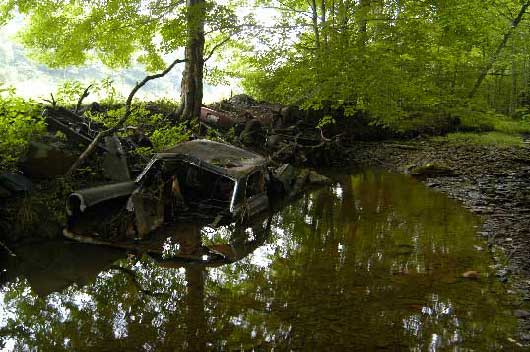Abandoned Cars, Clendenin Creek, Liberty, West Virginia

Someone dumped these cars in Clendenin Creek before my family bought our farm in Liberty. When the creeks were up, I’d go down there and swim around the one in the foreground. I was never tempted to swim inside it, for fear of getting caught on something and drowning; my best friend had gotten caught in fishing line and drown earlier that year (1974).
When you buy a farm in the boonies in West Virginia, it’s likely you’re also buying somebody’s dump; the “environment” wasn’t a concept to us, or the people who’d lived there before us; it was just a fancy name for everything around you. H.L. Mencken’s definition of Nature comes close to the way people saw “the outdoors” when I was a kid: Nature was “a place to throw empty beer cans on Sunday.”
I don’t remember anyone in those days talking about pollution (although Rachel Carson had written Silent Spring 12 years earlier, and the evidence was all around us, and in us. My surrogate dad, Foster Arthur (who I kind of adopted when my dad died when I was 13) told me his parents used to dust all the kids with DDT every day in summer, to keep lice off.
Around 2004 Liberty finally rated garbage service—meaning that (some) people have stopped throwing it over hillsides, or using it to fill ravines. A truck runs out the ridge, once a week, to haul away what hasn’t been thrown in someone’s ravine.
West Virginians are fighting a bigger battle than ‘what to do with garbage’ these days; they’re fighting mountaintop removal—the process of uncovering coal by stripping hundreds of feet of “overburden” (meaning forests, streams ...) to uncover a coal seam.
The nonprofit agency Mountain Justice (based in Naoma, West Virginia) leads off their description of mountaintop removal with this gut punch: “Forests are clear-cut; often scraping away topsoil, lumber, understory herbs such as ginseng and goldenseal, and all other forms of life that do not move out of the way quickly enough. Wildlife habitat is destroyed and vegetation loss often leads to floods and landslides. Next, explosives up to 100 times as strong as ones that tore open the Oklahoma City Federal building blast up to 800 feet off mountaintops ...”